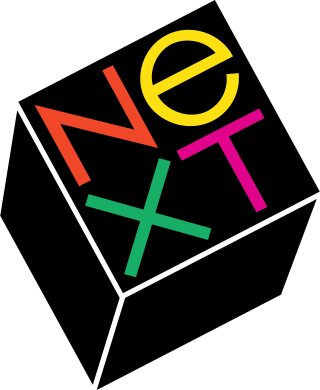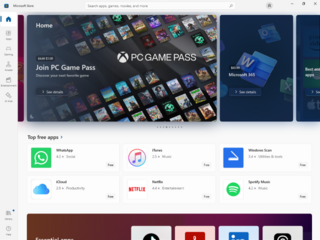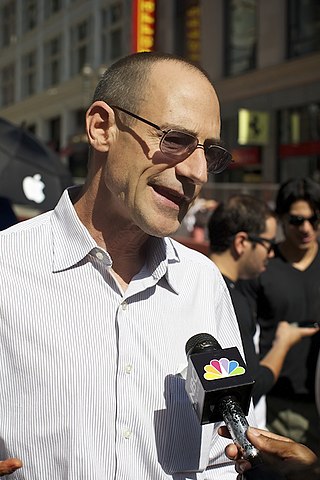
NeXT, Inc. was an American technology company that specialized in computer workstations intended for higher education and business use. Based in Redwood City, California, and founded by Apple Computer co-founder and CEO Steve Jobs after he was forced out of Apple, the company introduced their first product, the NeXT Computer, in 1988, and then the smaller NeXTcube and NeXTstation in 1990. These computers had relatively limited sales, with only about 50,000 units shipped in total. Nevertheless, their object-oriented programming and graphical user interfaces were trendsetters of computer innovation, and highly influential.

NeXTSTEP is a discontinued object-oriented, multitasking operating system based on the Mach kernel and the UNIX-derived BSD. It was developed by NeXT Computer in the late 1980s and early 1990s and was initially used for its range of proprietary workstation computers such as the NeXTcube. It was later ported to several other computer architectures.
OpenStep is a defunct object-oriented application programming interface (API) specification for a legacy object-oriented operating system, with the basic goal of offering a NeXTSTEP-like environment on non-NeXTSTEP operating systems. OpenStep was principally developed by NeXT with Sun Microsystems, to allow advanced application development on Sun's operating systems, specifically Solaris. NeXT produced a version of OpenStep for its own Mach-based Unix, stylized as OPENSTEP, as well as a version for Windows NT. The software libraries that shipped with OPENSTEP are a superset of the original OpenStep specification, including many features from the original NeXTSTEP.

GNUstep is a free software implementation of the Cocoa Objective-C frameworks, widget toolkit, and application development tools for Unix-like operating systems and Microsoft Windows. It is part of the GNU Project.
NeXT Computer is a workstation computer that was developed, marketed, and sold by NeXT Inc. It was introduced in October 1988 as the company's first and flagship product, at a price of US$6,500, aimed at the higher-education market. It was designed around the Motorola 68030 CPU and 68882 floating-point coprocessor, with a clock speed of 25 MHz. Its NeXTSTEP operating system is based on the Mach microkernel and BSD-derived Unix, with a proprietary GUI using a Display PostScript-based back end. The enclosure consists of a 1-foot die-cast magnesium cube-shaped black case, which led to the machine being informally referred to as "The Cube".

Lotus Improv is a discontinued spreadsheet program from Lotus Development released in 1991 for the NeXTSTEP platform and then for Windows 3.1 in 1993. Development was put on hiatus in 1994 after slow sales on the Windows platform, and officially ended in April 1996 after Lotus was purchased by IBM.

Apple Mail is an email client included by Apple Inc. with its operating systems macOS, iOS, iPadOS and watchOS. Apple Mail grew out of NeXTMail, which was originally developed by NeXT as part of its NeXTSTEP operating system, after Apple's acquisition of NeXT in 1997.

The Mac OS X Public Beta was the first publicly available version of Apple Computer's Mac OS X operating system to feature the Aqua user interface. It was released to the public on September 13, 2000 for US$29.95. Its release was significant as the first publicly available evidence of Apple's ability to ship the long-awaited "next-generation Mac operating system" after the Copland failure. It allowed software developers and early adopters to test a preview of the upcoming operating system and develop software for it before its final release. It is the only public version of Mac OS X to have a code name not based on a big cat until the release of 10.9 Mavericks in 2013. The US version had a build number of 1H39 and the international version had build number 2E14.

Stevenote is a colloquial term for keynote speeches given by Steve Jobs, former CEO of Apple, at events such as the Apple Worldwide Developers Conference, Macworld Expo, and Apple Expo. Because most Apple product releases were first shown to the public at these keynotes, "Stevenotes" caused substantial swings in Apple's stock price.
Project Builder was an integrated development environment (IDE) originally developed by NeXT for version 3 of the NeXTSTEP operating system by separating out the code editing parts of Interface Builder into its own application.

Simson L. Garfinkel is a Program Scientist at AI2050, part of Schmidt Futures. He has held several roles across government, including a Senior Data Scientist at the Department of Homeland Security (DHS), the US Census Bureau's Senior Computer Scientist for Confidentiality and Data Access. and a computer scientist at the National Institute of Standards and Technology (2015-2017). Prior to that, he was an associate professor at the Naval Postgraduate School in Monterey, California (2006-2015). In addition to his research, Garfinkel is a journalist, an entrepreneur, and an inventor; his work is generally concerned with computer security, privacy, and information technology.
NetInfo is the system configuration database in NeXTSTEP and Mac OS X versions up through Mac OS X v10.4 "Tiger". NetInfo replaces most of the Unix system configuration files, though they are still present for running the machine in single user mode; most Unix APIs wrap around NetInfo instead. NetInfo stores system wide network-type configuration information, such as users and groups, in binary databases; while Mac OS X machine and application specific settings are stored as plist files.

Read-only memory (ROM) is a type of non-volatile memory used in computers and other electronic devices. Data stored in ROM cannot be electronically modified after the manufacture of the memory device. Read-only memory is useful for storing software that is rarely changed during the life of the system, also known as firmware. Software applications for programmable devices can be distributed as plug-in cartridges containing ROM.
In the video game industry, digital distribution is the process of delivering video game content as digital information, without the exchange or purchase of new physical media such as ROM cartridges, magnetic storage, optical discs and flash memory cards. This process has existed since the early 1980s, but it was only with network advancements in bandwidth capabilities in the early 2000s that digital distribution became more prominent as a method of selling games. Currently, the process is dominated by online distribution over broadband Internet.
An app store is a type of digital distribution platform for computer software called applications, often in a mobile context. Apps provide a specific set of functions which, by definition, do not include the running of the computer itself. Complex software designed for use on a personal computer, for example, may have a related app designed for use on a mobile device. Today apps are normally designed to run on a specific operating system—such as the contemporary iOS, macOS, Windows, Linux or Android—but in the past mobile carriers had their own portals for apps and related media content.
The Intel AppUp center was a digital storefront for existing and new PC software, apps, content and entertainment, developed by Intel for Windows-based Ultrabook devices, netbooks, laptops, and personal computers. Peter Biddle, Intel AppUp's marketplace visionary, called Intel AppUp "the world's largest app store that nobody's ever heard of." Intel AppUp had a presence in more than 60 countries with the ability to conduct transactions in more than 45 countries in 5 languages.

Microsoft Store is a digital distribution platform operated by Microsoft. It started as an app store for Windows 8 and Windows Server 2012 as the primary means of distributing Universal Windows Platform apps. With Windows 10, Microsoft merged its other distribution platforms into Microsoft Store, making it a unified distribution point for apps, console games, and digital videos. Digital music was included until the end of 2017, and E-books were included until 2019.
A mobile application or app is a computer program or software application designed to run on a mobile device such as a phone, tablet, or watch. Mobile applications often stand in contrast to desktop applications which are designed to run on desktop computers, and web applications which run in mobile web browsers rather than directly on the mobile device.

Andrew "Andy" C. Stone is an American computer programmer best known for his iOS app Twittelator, which to date has sold over a million units for the iPhone and the iPad. The founder, director, and principal programmer for Stone Design Corporation, Albuquerque, New Mexico. In his 25 plus year career as a programmer, he has published over 35 software titles for Hypercard, the NeXT workstation, Mac OS X, and for iOS iPhones and iPads. He retired from software development in 2015.











